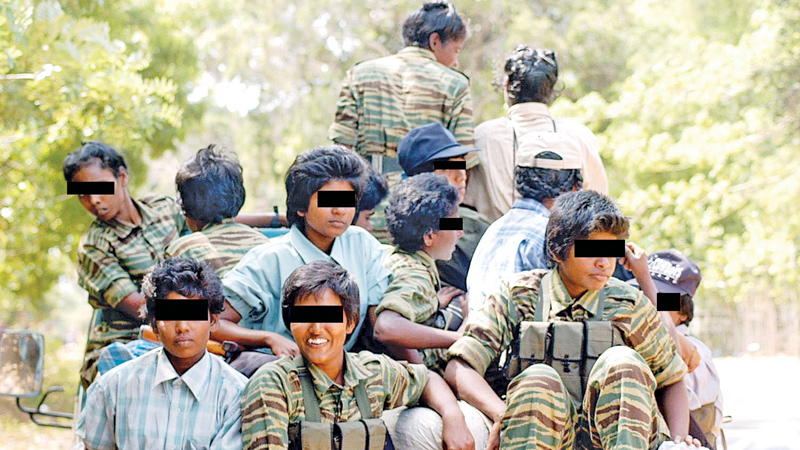The reference in the title is to those classified as ex-LTTE female cadre. Peter Schalk, in his article “Tiger Women,” says that 8 per cent of LTTE cadres killed in combat in the period 1982-1991 were women. The trigger for this article was a report in the Ravaya recently on former female cadre and their predicament where a woman speaks of how she was forcibly taken away coming from school and lived after being injured in the final days of the war in 2009. She speaks of coming back with the pain of surviving sexual advances of fellow cadre in bunkers. She survives with children taken care of by her father since her husband had left her for another woman.
LTTE women: is this liberation?
The sub title is from the Rajani Thiranagama Memorial lecture by Radhika Coomaraswamy in 1997. She goes on to say, “I do not believe that inducting women into a fighting force is a step towards empowerment and equality. Whatever reservations we may have about the overall militarisation of women, there is no doubt that the actual role of women in Tamil society has been drastically altered. Once peace returns, will Tamil society revert to casteism and oppressive sexist practices? A cursory glance at the Tamil diaspora in other countries seems to imply that once people leave the atmosphere of war and return to some semblance of peace, the rituals and practices return. The LTTE privileges two types of women - the militant mother and the armed virgin.”
The Ravaya story basically says when you keep four men with a female on bunker duty in the jungle the men were not focused on keeping the bunker safe.
Pushing back further, the label of female cadre is as wrong as that of a male cadre.
Conscription
DBS Jeyaraj in a piece in 2010 reports -, “Eelam People’s Revolutionary Liberation Front (EPRLF), Eelam National Democratic Liberation Front (ENDLF) and Tamil Eelam Liberation Organization (TELO) created a civilian volunteer force cum Tamil National Army. The LTTE adopted such methods after 1995. The LTTE and later its off-shoot the Tamil Makkal Viduthalai Puligal (TMVP) took conscription to new heights or depths. Most of the surrendees therefore were forcibly recruited conscripts or unwilling “volunteers”.
The LTTE had insisted that each family in the Wanni had to provide one recruit to the LTTE. In the latter stages the Tigers demanded two per household. It became an accepted norm that no family dared refuse or defy. In a spirit of self-sacrifice boys and girls would opt to join the movement and thus protect other siblings from being recruited. Brothers would opt to join so that their sisters would be spared. Elder sisters would join in place of younger sisters. Usually siblings would decide that the cleverer among them should not be deprived of higher education and so the comparatively less studious ones would join thereby enabling the others to continue with studies. Thousands of youths were virtual cannon fodder and had perished like sacrificial lambs.”
Families hid kids in wells, trees and even stacks of paddy or were forcibly married off to prevent being conscripted.
Rehabilitation and re-integration
The final count was 11,696 comprising 594 children and 11,102 adults. The children consisted of 363 boys and 231 girls. The adults consisted of 9,078 men and 2024 women. One thousand one hundred and seventy of the surrendees were disabled persons having lost limbs in the war. They were released and allowed to be with their families. These included some hard core Tigers and senior leaders. Likewise persons over the ages of 50 were also released. One hundred and forty eight among the surrendees were University students from Jaffna. Later 51 female undergrads were released and allowed to resume studies in Jaffna. This was followed by 97 male undergrads.
Most of Sri Lankan society accepted the label of ex-cadre. The grim reality was youth male and female lost out on their teens because they were conscripted or sacrificed themselves to save siblings.
Within which are the stories of what girls underwent. Any truth telling process must listen to the antecedents and narratives of the survivors. As Jeyaraj says thousands perished as cannon fodder. The agony of their surviving families need to heard.
Our rehabilitation process subject to correction has never looked at the surrenderees amongst who were conscripts as victims. All were classified as former cadre.
This writer believes that re-integration and restorative justice must take into account the manner in which Tamil groups conscripted youth, taking away their teens as civilians. Those fortunate to survive live but are scarred.
It does seem the LTTE was not really serious about having “armed virgins” when the boys were essentially interested in having sex with their female counterparts in closed, cloistered surroundings. The truth of this assertion can be validated if we were to take time listen to their stories not merely to document but rather to recognize the horror they went through and for many of us to recognize and acknowledge our failure to prevent such crimes from occurring in thousands of cases with impunity.
This writer is privy to concepts such as Children Zones of Peace and the work of the UN to prevent children being used in armed conflict which were unsuccessful in Sri Lanka. Its cause for collective shame and time to open another aspect of truth seeking in our goal for restorative justice.
Radhika’s question in 1997 when she asks,” will Tamil society revert to casteism and oppressive sexist practice is relevant in that Tamil society it seems accepts some have suffered but it stops there. If not we should have done more for them by now.



Add new comment